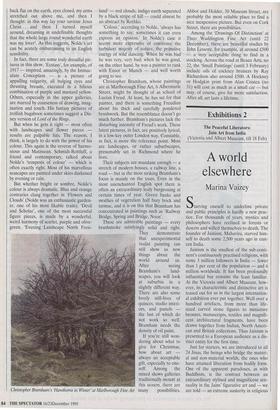Exhibitions 2
The Peaceful Liberators: Jain Art from India (Victoria and Albert Museum, till 18 Feb)
A world elsewhere
Marina Vaizey
Starving oneself to underline private and public principles is hardly a new prac- tice. For thousands of years, mystics and philosophers have reclined in forests or deserts and willed themselves to death. The founder of Jainism, Mahavira, starved him- self to death some 2,500 years ago in east- ern India.
Jainism is the smallest of the sub-conti- nent's continuously practised religions, with some 3 million followers in India — fewer than 1 per cent of the population — and 6 million worldwide. It has been profoundly influential but remains the least familiar. At the Victoria and Albert Museum, how- ever, its characteristic and distinctive art is teased out for us in the largest internation- al exhibition ever put together. Well over a hundred artefacts, from more than life- sized carved stone figures to miniature bronzes, manuscripts, textiles and magnifi- cent architectural fragments, have been drawn together from Indian, North Ameri- can and British collections. Thus Jainism is presented to a European audience as a dis- tinct entity for the first time.
Just for starters, we are introduced to all 24 Jinas, the beings who bridge the materi- al and non-material worlds, the ones who have attained liberation from bodily form. One of the apparent paradoxes, as with Buddhists, is the contrast between an extraordinary stylised and magnificent sen- suality in the Jains' figurative art and — we are told — an extreme austerity in religious practice. We would not be able to deduce this from the splendour of the sculpture: a host of carved stone figures, the males still and serene, and usually well-endowed, the women with exaggerated curves, tiny waists, enormous melon-shaped breasts and broad hips, all in praise of fertility. The idealised figures — deities, celestial beings — are sumptuous, compelling and beguil- ing. Yet nirvana was to be attained by denying desire and following a philosophy of non-violence.
In spite of self denial, the Jains have had a sustained and prosperous history since their foundation. Those Jains who are not monks and nuns are affluent as well as articulate. Jains don't believe in posses- sions yet they are merchants and traders an eastern variant perhaps of religion and the rise of capitalism. This wealth has meant the patronage of temples and even, as a logical extension to their reverence for life (one of Jainism's central doctrines is non-injury to living creatures), the support of animal sanctuaries.
A gleaming, elaborate model of an ideal mediaeval Jain temple, painstakingly carved in white marble over the past two years in Ahmedabad in western India, reposes in splendour at the entrance to the V & A exhibition. Opposite the temple, there is an elaborate floor painting in sand, a rangoli, vividly coloured and intricately patterned. The mown has been made on site by simply dribbling coloured sands through the fingers: impermanent, beauti- ful and traditional.
The finished model and the new sand painting represent two things that western- ers find riveting, mysterious, and beguiling about the religious life and practices of the Indian sub-continent: that ancient rituals are omnipresent, and more than willingly undertaken (however handicapping to daily life from many western points of view), and that there is an utterly different sense of time and history — a continuing cycle from which the goal of the living soul is libera- tion.
`Pick a carol. •











































































































 Previous page
Previous page